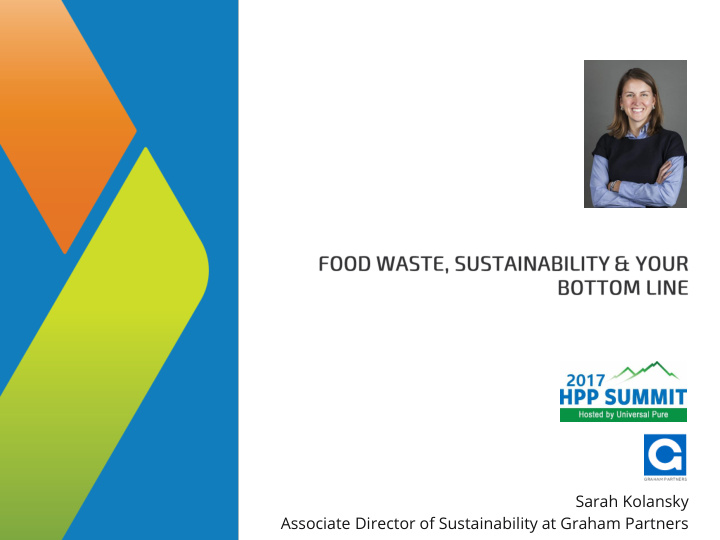



Sarah Kolansky Associate Director of Sustainability at Graham Partners
Sarah Kolansky Associate Director of Sustainability at Graham Partners • Joined the Graham Partners Sustainability team in February 2017 • From 2010-2017: Climate Change and Sustainability for ICF • Led Inventory of GHG emissions for Yard Trimmings and Food Scraps for EPA • Worked with USDA Climate Change Division to create tools to emissions from food production, including Animal Agriculture, Crop Management • Worked on EPA’s WARM model which estimates changes to emissions from different waste management decisions • B.S. in Civil and Environmental Engineering degree from Bucknell University • Master of Environmental Studies degree from the University of Pennsylvania
Outline for Today • Introduction • Evolution of America’s Relationship with Food • Impacts of Food Waste • New Demands for Discarded Produce • How Does this Affect a Company’s Bottom Line? • Breakout into Groups • Q&A
The Extraordinary Life and Times of a Strawberry
How Much Food is Actually Wasted? Every day, America wastes enough food to fill the seats at the Rose Bowl Stadium
EVOLUTION OF AMERICA’S RELATIONSHIP WITH FOOD
Our Value of Food has Changed
Our Value of Food has Changed
Our Value of Food has Changed
Our Value of Food has Changed
And Our View of Food has Changed Food and calories are fast…
And Our View of Food has Changed And cheap!
And Our View of Food has Changed Customers expect perfect produce
IMPACTS OF FOOD WASTE
Key Food Waste Facts 133 billion pounds of the 430 billion pounds of food produced in the U.S. in 2010 was not available for human consumption at the retail and consumer levels. Equal to: • $161.6 billion (as purchased at retail prices) • 31 percent of food produced • 141 trillion calories per year, or 1,249 calories per capita per day
Social Impacts We waste roughly 30% of food produced, yet, in the US, • 50 million people (13% of the population) lived in food insecure households in 2011 • Over 35% of Americans are obese and over 70% of Americans are overweight or obese. This doesn’t add up!
Environmental Impacts Agriculture uses: • 70% of freshwater for irrigation • 38% of ice-free land • ≈30% of global energy consumption (agricultural machinery, fertilizer, transport, drying, cooling, processing, manufacturing, packaging, retail, domestic refrigeration, cooking, etc.) US annual food wastage represents: • 300 million barrels of oil (4% of total US oil consumption) • ¼ of annual U.S. freshwater consumption
Climate Change Impacts Food waste that is sent to a landfill creates methane gas If it is not captured by the landfill, then the methane is released into the atmosphere Methane (CH 4 ) is 23 times as potent of a greenhouse gas (GHG) than CO 2 Accounts for 25% of U.S. methane emissions
Environmental Impacts
Future Impacts By 2050, the world population will be 9.725 billion… How will we feed a billion more people?
Food Waste Hierarchy Source Reduction is the best thing that you can do to reduce impact from food waste. Perception that composting is the best practice, but there are many uses above composting that should be pursued. Wide consensus that landfilling should be the last resort, not the default.
Food Waste In the Supply Chain All types of food are wasted throughout each phase of the supply chain
NEW DEMANDS FOR DISCARDED PRODUCE
The Market is Creating a Demand for Food Waste Number of Food Waste Innovation Organizations Source: ReFED Food Waste Innovators Database
Companies are Sprouting Up
And All Over the World Whole Foods, Walmart, and dozens of start-ups are finding new markets for imperfect produce?
And Over the US
Some with Social Missions
Others that are for Profit
HOW DOES THIS AFFECT A COMPANY’S BOTTOM LINE?
Consumers are Seeking Socially Responsible Companies
Sustainability and Shareholder Value • In the end, companies have a responsibility to shareholders to create value • The fastest-growing cause for shareholders is sustainability • High environment, social governance (ESG) ratings correlates to: • Lower cost of capital in 100% of the studies • Market-based outperformance in 89% • Accounting-based outperformance in 85%
Wasted Food = Wasted $$$ • Shrink in production, processing, and retail means dollars wasted • Finding a market for this shrink can mean that this is not written off as a loss • Laws in place to protect company who donates in good faith
BREAKOUT INTO GROUPS
Breakout Into Groups • How does your organization think about sustainability? A. Responding to customer/consumer demands B. Environmental impact (e.g., energy/water/waste efficiency) C. More of a corporate social responsibility (CSR) effort, based around corporate citizenship • Is there buy-in from top-level management on sustainability? • Where is the shrink in your supply chain? What do you do to with this waste? How much does that cost you/the supply chain to dispose of it? • Think back to the food waste hierarchy. Are there better uses for the food than the status quo? • How does HPP fit in with these sustainability goals? Can HPP help to achieve goals by extending shelf life and therefore reducing food waste?
Q&A
Thanks For Participating Sarah Kolansky Email: skolansky@grahampartners.net Twitter: @skolansky
Food Waste Resources • http://www.foodwastemovie.com/ • http://www.adcouncil.org/Our-Campaigns/Family-Community/Reducing-Food-Waste • https://www.usda.gov/oce/foodwaste/ • https://www.epa.gov/sustainable-management-food • https://www.nrdc.org/sites/default/files/wasted-food-IP.pdf • https://today.law.harvard.edu/food-law-and-policy-clinic-releases-short-film-on-food-waste-in-america/ • https://www.nrdc.org/sites/default/files/dating-game-report.pdf • https://www.refed.com/downloads/ReFED_Report_2016.pdf • https://www.ers.usda.gov/webdocs/publications/43833/43680_eib121.pdf?v=41817 Other, more technical information • https://www.epa.gov/sites/production/files/2017-02/documents/2017_chapter_7_waste.pdf • https://www.epa.gov/smm/advancing-sustainable-materials-management-facts-and-figures
THANK YOU!
Recommend
More recommend